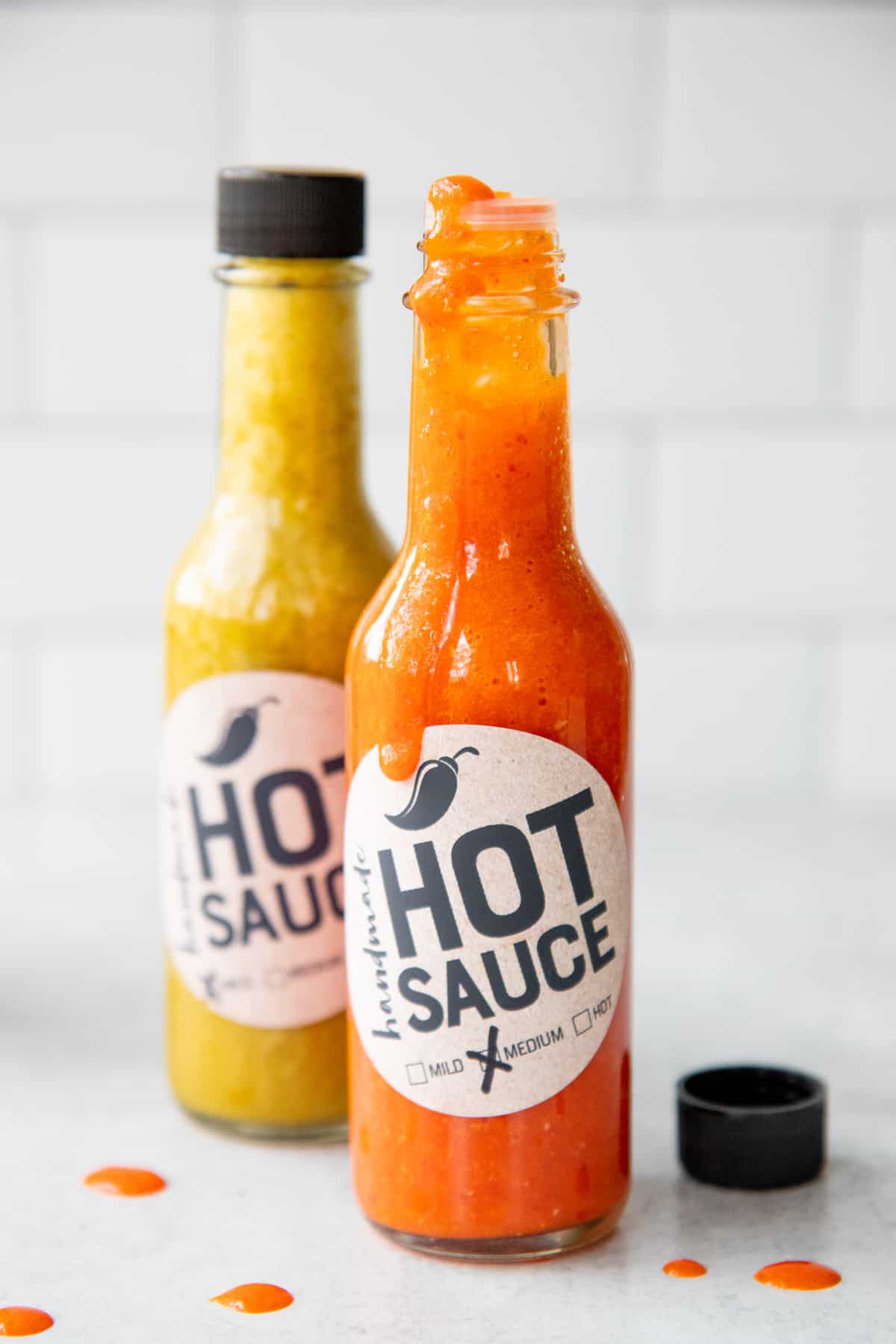I used to be a total hot sauce hater. I didn’t get why people would douse their food in something so spicy that you couldn’t taste anything else!
My tune was changed a few years back when I was gifted a more mild hot sauce that was bursting with layered flavor. It tasted vinegary. It tasted sweet. And of course, it tasted spicy. Suddenly, I was a total hot sauce convert!
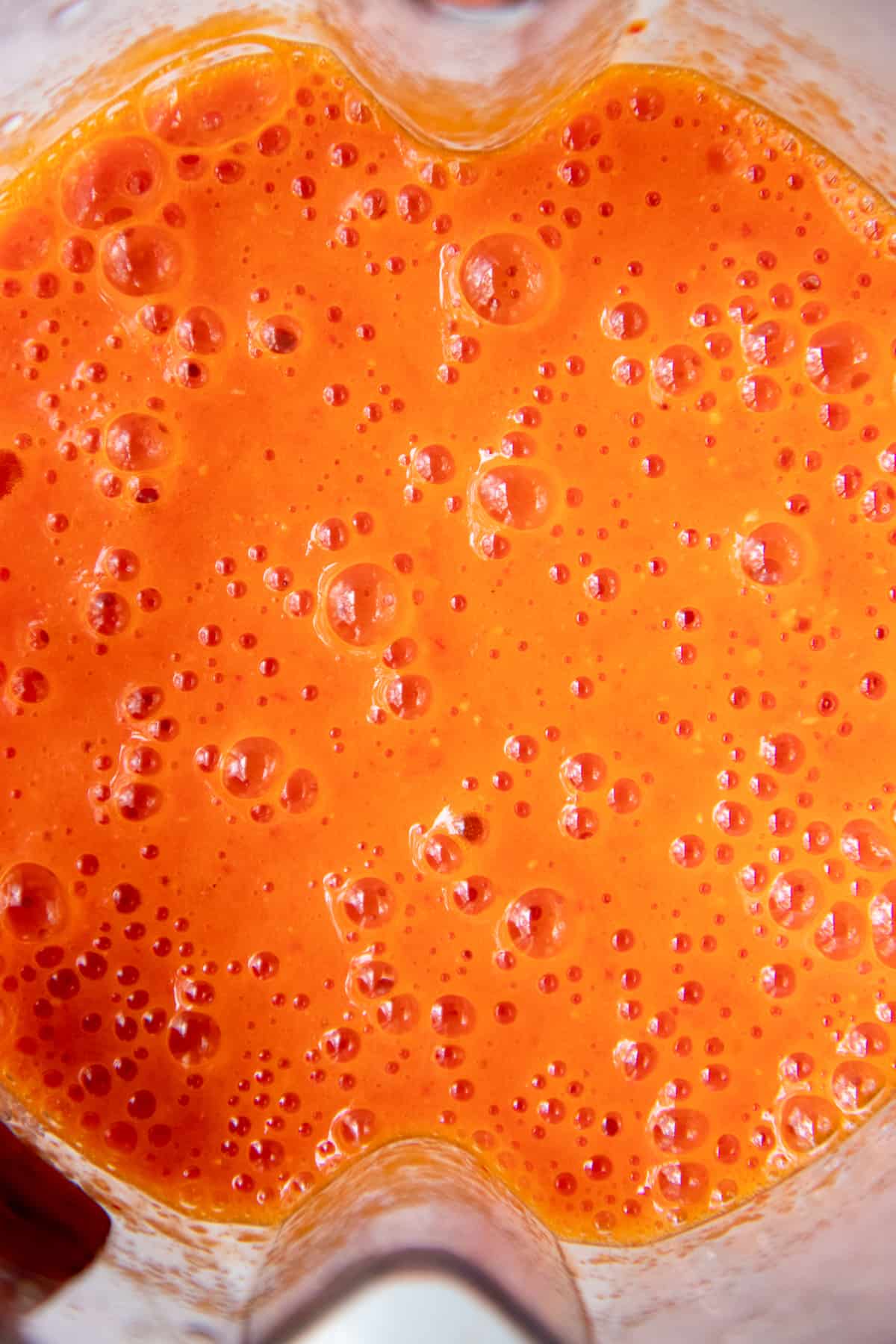
Now, we rarely have a meal where there isn’t a hot sauce bottle on the table (and more often than not, multiple bottles). In fact, we love hot sauce so much, I’ve taken to making my own! This started off as a fun project to use up a bounty of peppers from a garden, and turned into a homemade hot sauce delicious enough to package up and give for gifts!
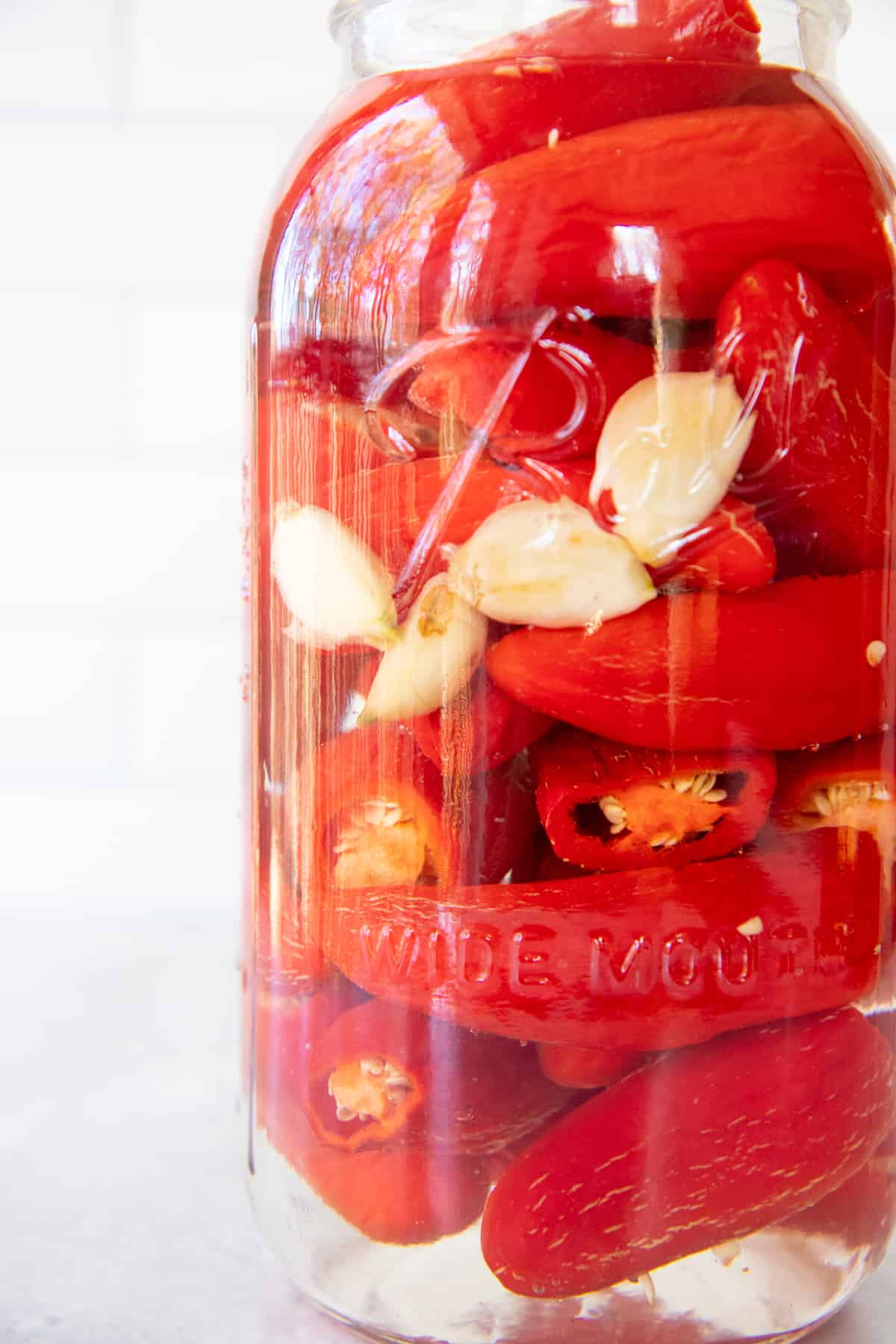
How do you make hot sauce? What’s it made of?
The traditional way of making hot sauce involves fermenting either straight hot peppers or a mix of hot and sweet peppers and other aromatic veggies (like garlic or onion). When the fermentation time is up, the whole shebang is blended with vinegar until smooth as silk. To help keep the hot sauce from separating, emulsifiers are usually used during the blending process—we recommend xanthan gum—which keeps the hot sauce smooth when bottled.

Wait. Do you have to ferment homemade hot sauce?
Don’t get intimidated! This is a super easy fermentation—even easier than sauerkraut—and it gives a complex, interesting flavor to the hot sauce. Here’s how easy it is to ferment your own hot sauce:
- Combine salt with warm, filtered water to create a brine.
- Fill a jar with peppers and garlic.
- Cover with brine.
- Cover the jar with a fermentation lid or cheesecloth, and let ferment for 5-7 days (or until the brine looks cloudy).
Wholefully Protip
If you choose to use cheesecloth, you’ll need to use some sort of weight to keep the peppers submerged under the brine. You can purchase speciality weights to do this, or fill a zip-top sandwich bag with water and submerge it in the top of the jar.
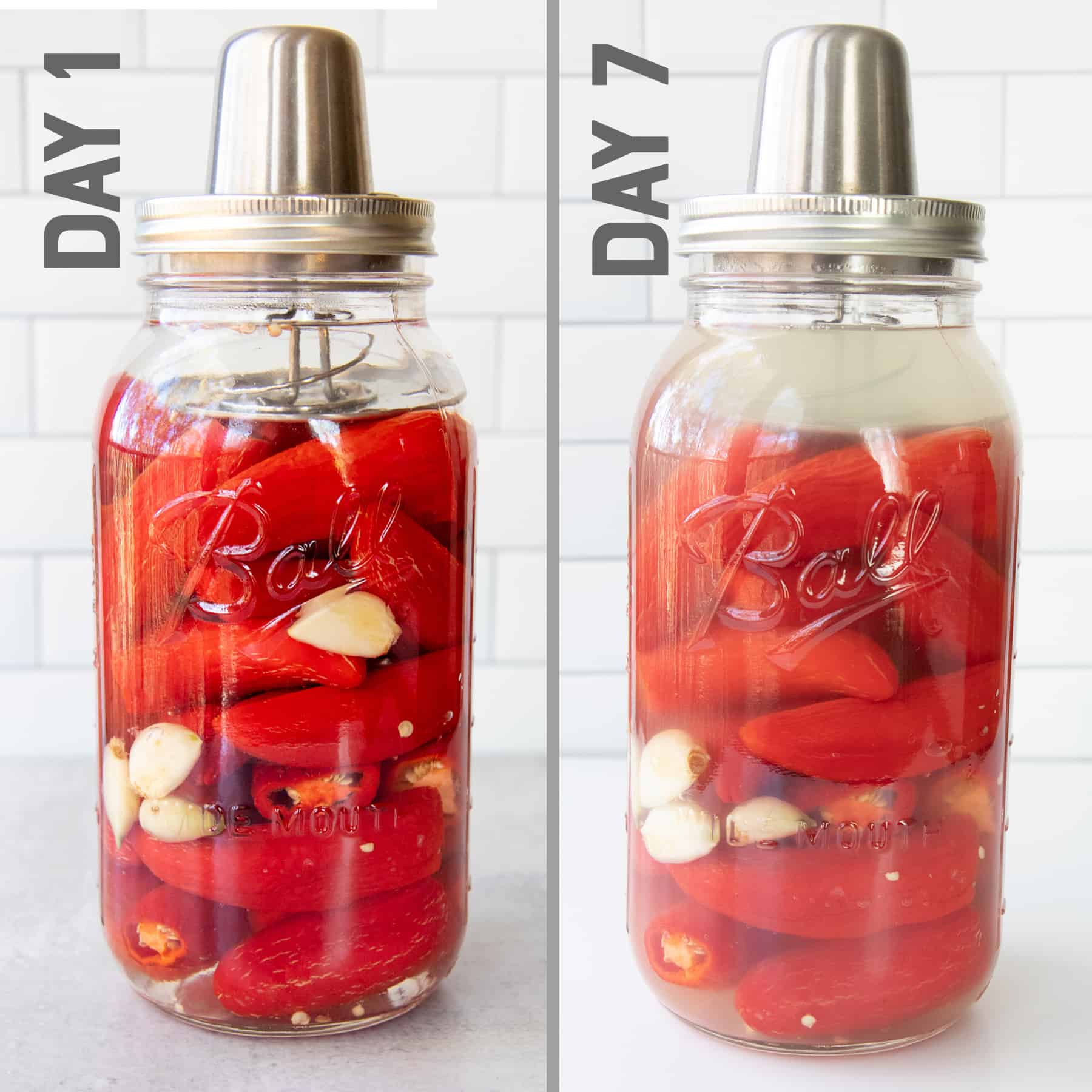
That being said, if fermentation isn’t your thing, we do provide a quick cook version in the recipe card below. It doesn’t have quite the complex flavor of the fermented version, but it’s done in a jiffy! It also doesn’t last as long in the fridge—make sure you use your unfermented hot sauce within a couple of weeks.
What are the best peppers to use for homemade hot sauce?
Jalapeños, reapers, Thai chilies, habanero, cayenne, ghost peppers, serranos, OH MY. It’s easy to get lost in the world of chile peppers! Which hot peppers you use really depends on your personal heat tolerance, the flavor profile you’re looking for, what’s available nearby, and pepper color. Yup, color! Feel free to mix and match different types of peppers to get the flavors and heat levels you desire, but make sure you stick to the same color family. Why? Well, if not, you’re going to end up with a brown hot sauce—which, trust me, doesn’t look so appetizing when drizzled on your food. The two hot sauces in the photos here were made with these mixes:
- Red Medium Hot Sauce: Red bell peppers, red cayenne peppers, and red jalapeño peppers (we let jalapeños ripen until they were red)
- Green Mild Hot Sauce: Green bell peppers, green jalapeños, and poblanos
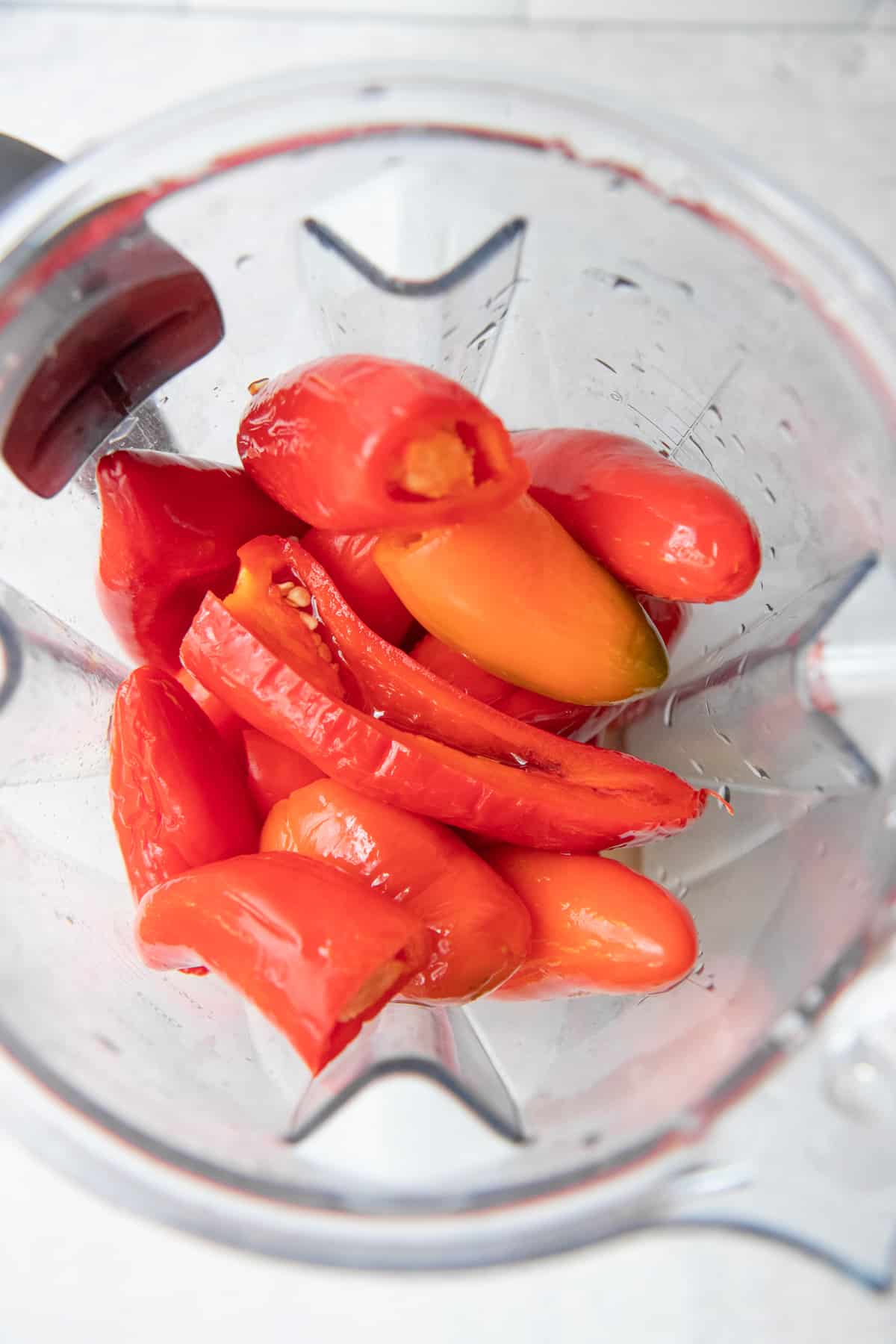
Whatever you choose, just remember that you can always add more spice in, but you can never take it out once it’s been blended. I tend to like a more mild hot sauce, so I start with a 3:1 ratio of sweet peppers to hot peppers. When using a milder hot pepper, like jalapeño, I cheat to more like 2:1 or 1:1. Some folks use nothing but hot peppers—so it really is up to you to pick your poison here. Remember: you can always have an extra super spicy pepper nearby to drop into the blender if you want to up the ante. I recommend checking out a Scoville scale (which tells you how spicy peppers are) and making your plan based on that.
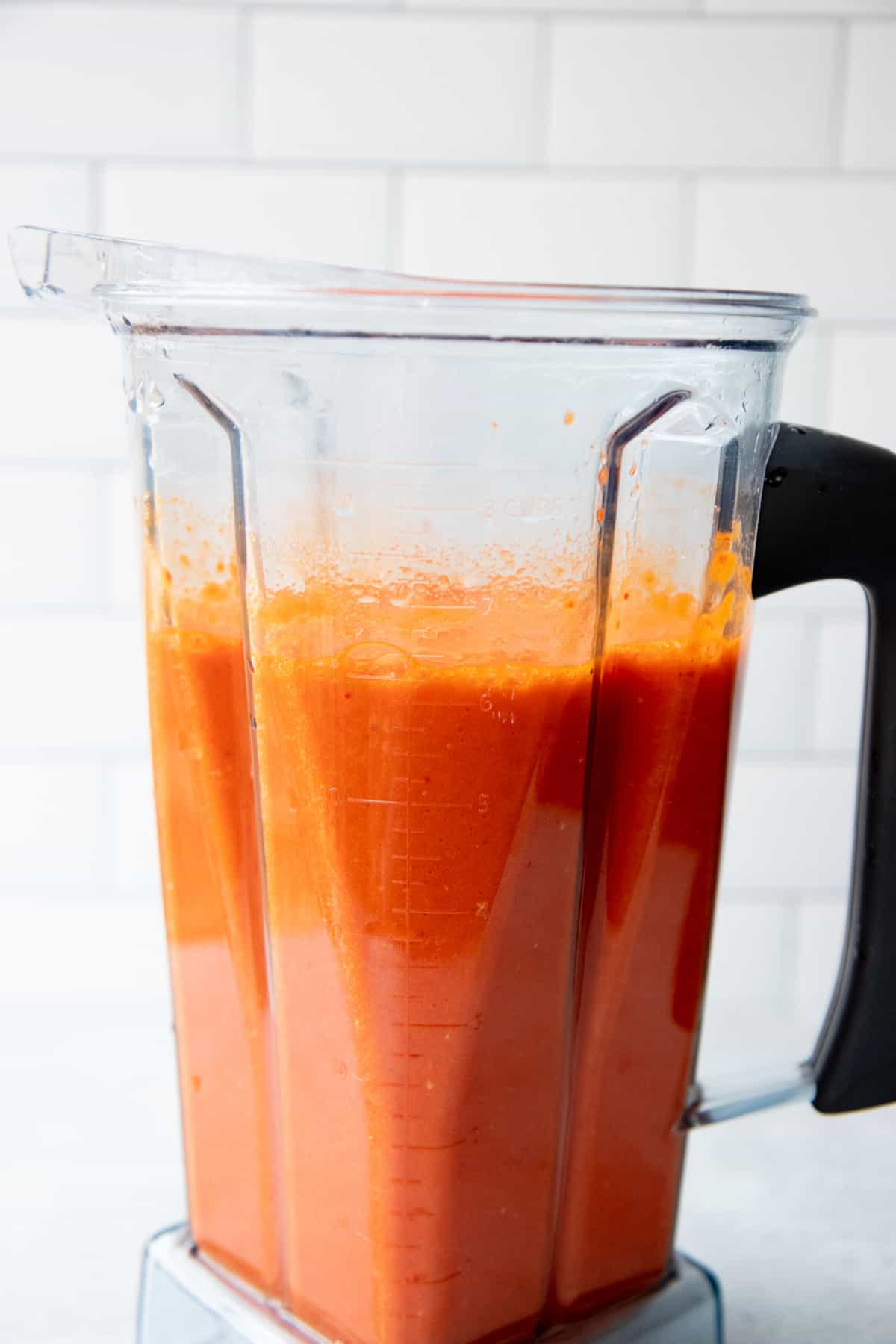
A word of warning about working with hot peppers:
Let’s stay safe here when working with hot peppers. So even when you’re working with “mild” hot peppers like poblanos and jalapeños, it’s important to:
- Wear gloves while handling and cutting.
- Wash hands extremely well after handling.
- Wear goggles and work in a well-ventilated area (this is particularly true with super hot peppers).
- Wash all cutting boards, knives, and utensils well after preparing.
What is the best vinegar for hot sauce?
Vinegar adds a tangy flavor, and it also adds acidity to the hot sauce—making it have a much longer shelf life. You can use either white distilled vinegar or apple cider vinegar here. I prefer the slight fruity flavor of apple cider!
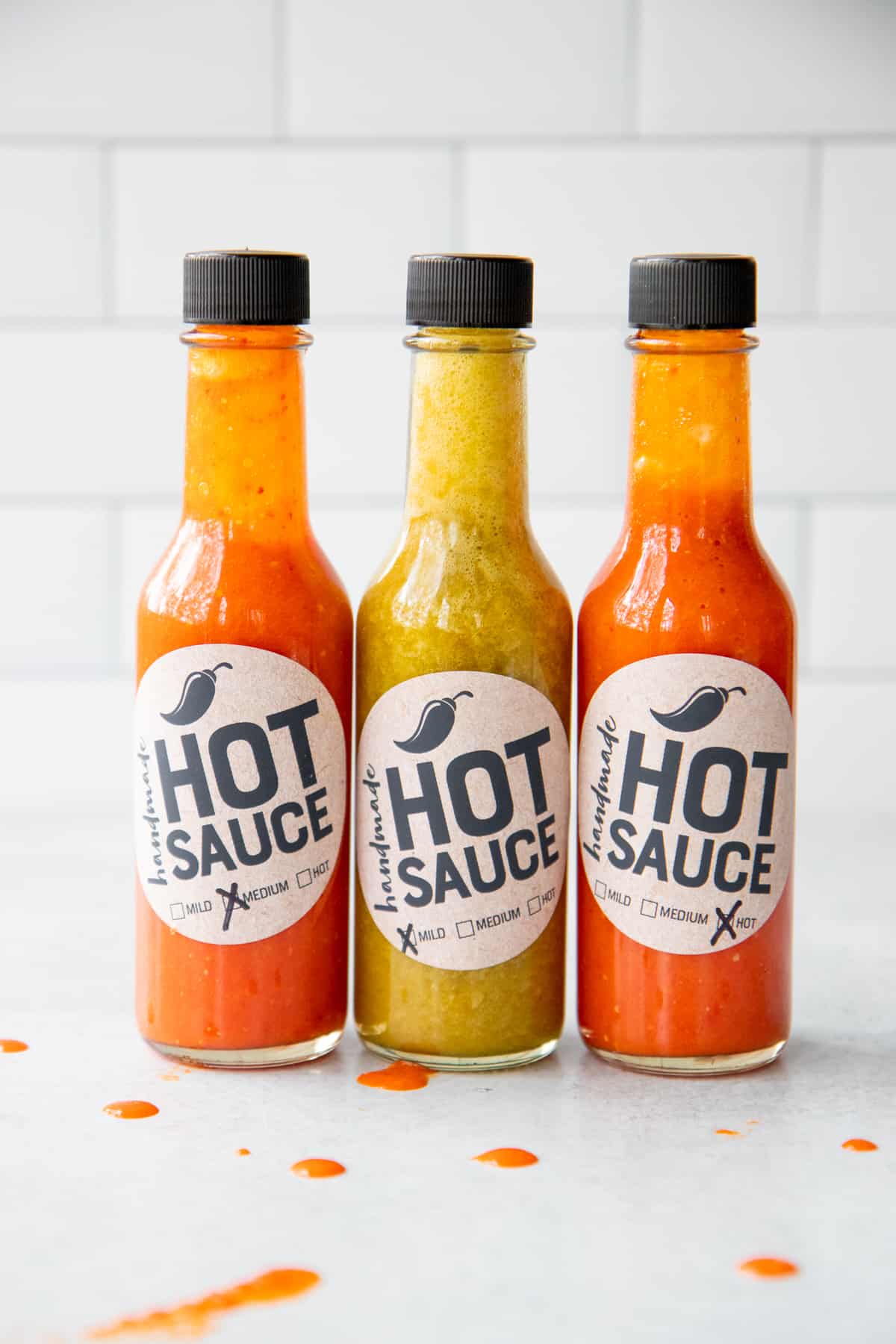
How long does homemade hot sauce last?
The beauty of this acidic hot sauce is that it’ll easily last quite awhile in the fridge! Our quick cook version lasts in the fridge for 2-3 weeks, and the fermented version will last much longer—easily 3-6 months. Thank you, beneficial bacteria!
What’s the best way to preserve homemade hot sauce? Can it? Freeze it?
If you’d like to preserve your hot sauce for longer storage, you can either freeze it or process it in a waterbath canner (if you choose to can hot sauce, use a recipe that has been tested and proven safe for canning instead of ours). A caveat here: the beneficial bacteria created in the fermented version will be killed off by the high heat from the canning process. It’ll still be delicious, it just won’t add any probiotics into your diet.
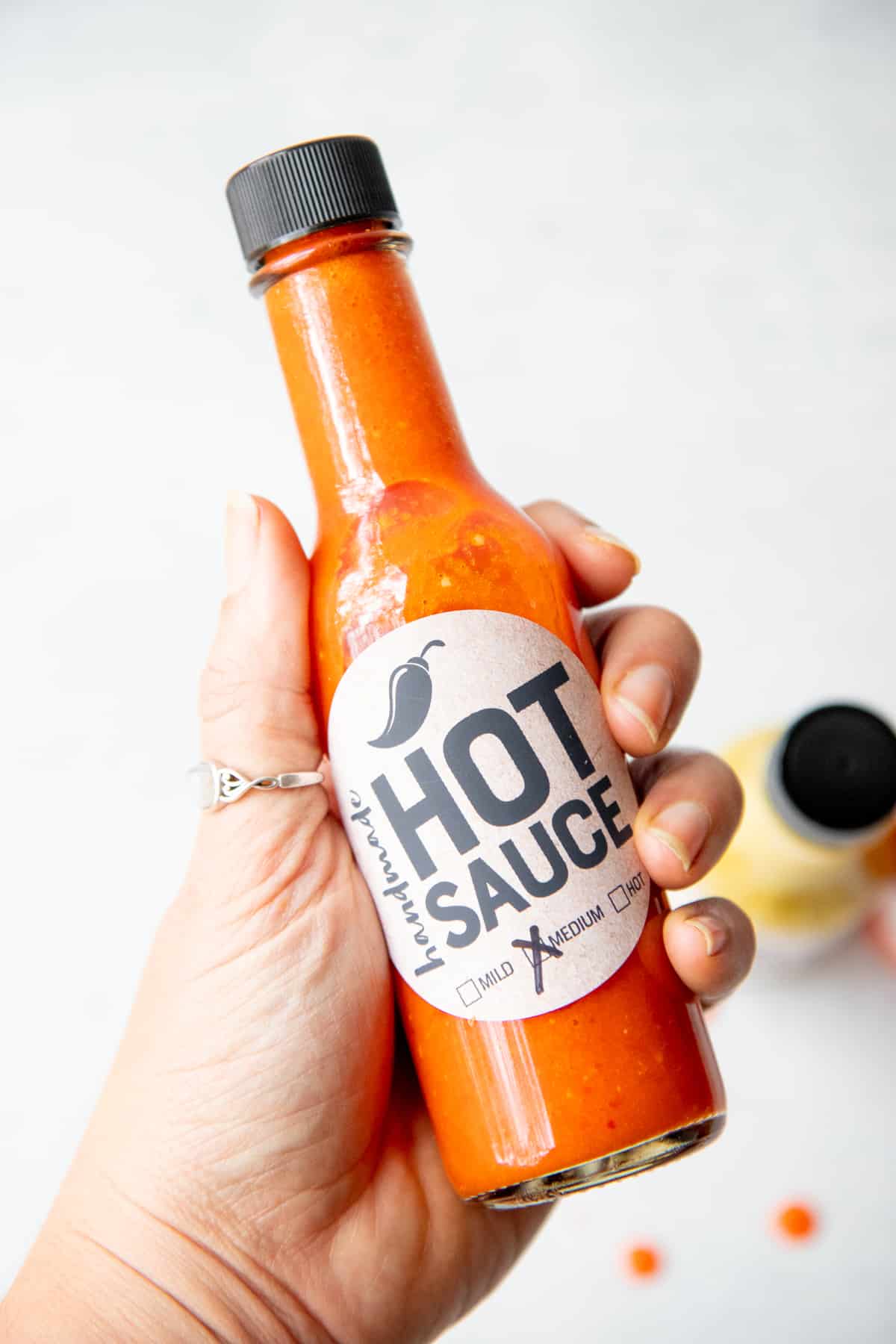
What are the best bottles for homemade hot sauce?
The ones you have! I’m a big believer in upcycling and reusing what you have, so any small bottle with a tight fitting lid will do the trick. If you can’t get your hands on bottles to reuse, I really like these hot sauce bottles from Amazon. These are what we package our hot sauce in for gift giving.
Where can you get those snazzy hot sauce labels?
Download our free hot sauce labels here. These are designed to print on Avery 2 1/2” round water-resistant labels. The water-resistant part is really nice when working with a food product that inevitably ends up on the bottle. If you can’t get your hands on these labels, you could also affix a regular paper label and just cover it with clear packing tape.
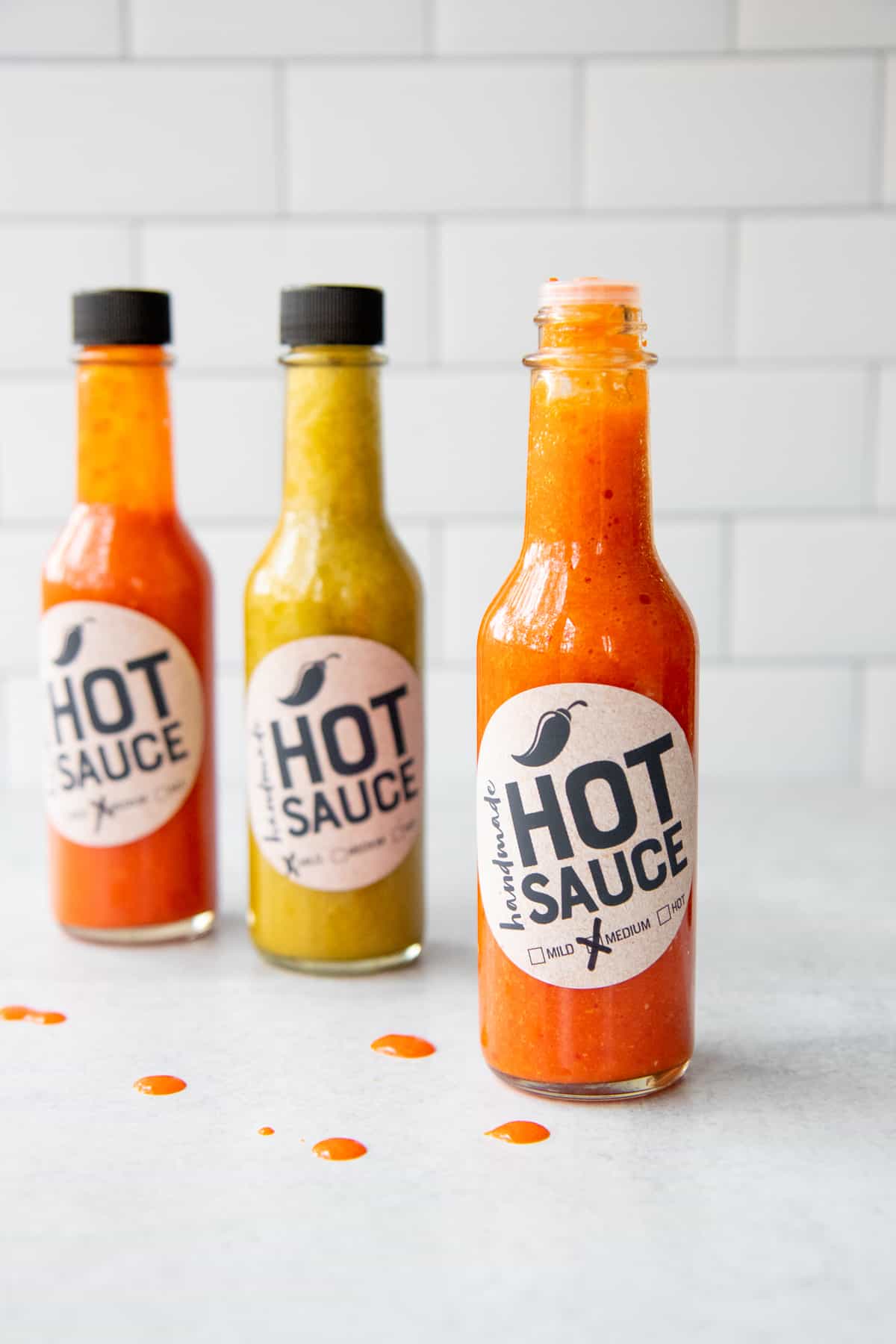
And check out these reader favorites!
- Bread and Butter Pickles. These are the simplest pickles you can make. Mix up a batch to eat straight out of the refrigerator, or can a batch for later!
- Mixed Berry Jam. Jars of this red-purple jam make for beautiful gifts—just wrap a ribbon and label around the rim, and you’re all set.
- Homemade Sauerkraut. If you’re new to fermenting, sauerkraut is the perfect place to start.
- Canned Salsa. We can’t get enough of this zesty salsa, and canning it means we can have delicious salsa all year long.
- Homemade Limoncello. This Italian lemon liqueur is sweet and boozy and makes a great gift.
- Instant Pot Apple Butter. Make your own spiced apple butter at home. It’s fast and easy with the use of the Instant Pot!
- Strawberry Wine. If you’ve never made fruit wine before, you’ve got to try it. The process is straightforward, and the results are absolutely amazing!
I hope you have fun experimenting with hot sauce making in your own kitchen! It is easy and the results are absolutely delicious. Enjoy!
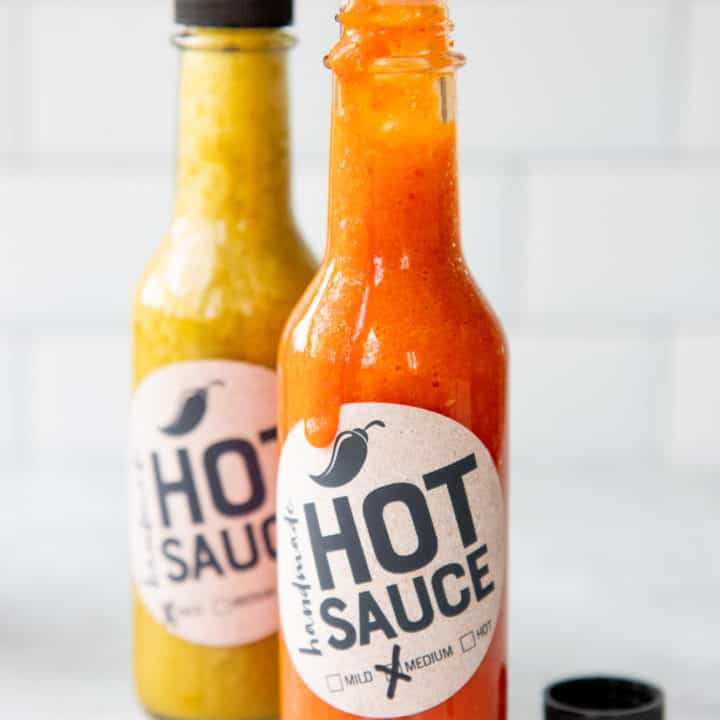
Homemade Hot Sauce (Fermented or Quick Cook Recipe)
Homemade hot sauce makes a perfect gift! Make either traditional fermented hot sauce or a quick cook version, which is done in less than half an hour.
Ingredients
- 1 1/2 pounds peppers of your choosing (a mix of sweet peppers and hot peppers), tops/stems removed, halved
- 6 cloves garlic, peeled
- 4 cups filtered water
- 4 teaspoons sea salt
- 1/3 cup apple cider vinegar
- 1 tablespoon honey or maple syrup, optional
- 1/2 teaspoon xanthan gum, optional (see notes)
Instructions
For the Fermented Version
- Place the peppers and garlic in a clean wide-mouth quart canning jar. Set aside.
- To make the brine, heat the filtered water and sea salt in a medium saucepan until the salt has dissolved completely. Let cool to room temperature.
- Pour the brine over the peppers and garlic, completely submerging them. If you run out of brine, you can make more by mixing 1 cup of warm filtered water with 1 teaspoon of sea salt.
- Fit the jar with a fermentation lid or cheesecloth secured with a rubber band (see notes on weighing down the peppers if using cheesecloth). Place in a warm, dark spot for 5-7 days, or until the brine looks cloudy and small bubbles begin to appear when you tap the side of the jar. Make sure the peppers stay submerged under the brine during the entire fermentation process to prevent mold-growth.
- When the fermentation time is up, strain the brine, reserving it. Place the fermented peppers and garlic in a blender, and add in 1 cup of the brine, plus the apple cider vinegar, and honey or maple syrup, if using. Blend until completely smooth, adding in additional brine to reach the desired thickness.
- While the blender is running, sprinkle in the xanthan gum, if using, and blend for an additional minute.
- Transfer to a bottle and store in the fridge for 3-6 months.
For the Quick Cooked Version
- Combine the peppers, garlic, 2 cups of water, 2 teaspoons of sea salt, apple cider vinegar, and honey or maple syrup, if using, in a medium pan over medium-high heat. Bring to a boil, reduce heat, and simmer for 10-15 minutes, or until the peppers and garlic have softened.
- Pour mixture into a blender (making sure to leave the cover vent open, but covered with a kitchen towel) and blend until very smooth.
- While the blender is running, sprinkle in the xanthan gum, if using, and blend for an additional minute.
- Transfer mixture to a squeeze bottle and store in the fridge for 2-3 weeks.
Notes
- If you choose to use cheesecloth during fermentation, you’ll need to use some sort of weight to keep the peppers submerged under the brine to prevent mold growth. You can purchase specialty weights to do this, or fill a zip-top sandwich bag with water and submerge it in the top of the jar.
- In this recipe, xanthan gum works as an emulsifier, stablizer, and thickener. It is 100% optional. If you choose not to use it, your hot sauce will separate in the fridge. Just give it a good shake each time you go to use it.
- The hot sauce will thicken considerably in the fridge, so keep that in mind as you decide on the consistency while blending.
- Depending on the power of your blender, your hot sauce may be foamy when you’re finished blending. If so, let the hot sauce rest for 15-20 minutes, then scrape off any foam before bottling.
- Get your printable labels here.
Nutrition Information:
Yield: 384 Serving Size: 1 tspAmount Per Serving: Calories: 1Total Fat: 0gSaturated Fat: 0gTrans Fat: 0gUnsaturated Fat: 0gCholesterol: 0mgSodium: 22mgCarbohydrates: 0gFiber: 0gSugar: 0gProtein: 0g
At Wholefully, we believe that good nutrition is about much more than just the numbers on the nutrition facts panel. Please use the above information as only a small part of what helps you decide what foods are nourishing for you.

